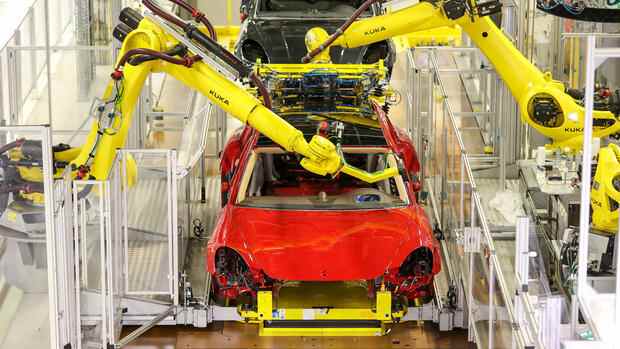Increasingly simpler and cheaper models are also making their use attractive for companies outside the automotive industry.
(Photo: dpa)
Munich The automation boom in times of Corona and the Ukraine war surprised even the robotics industry. “We had forecast a surge after the pandemic,” said Susanne Bieller, Secretary General of the World Industry Association IFR, the Handelsblatt. “But our expectations were once again clearly exceeded.”
Last year, sales increased by 31 percent to a record 517,385 newly installed robots, as the association announced on Thursday. The growth was thus once again significantly stronger than initially estimated. Originally, the IFR had not expected to surpass half a million copies sold until 2024.
This means that sales have more than doubled in the past six years. According to industry estimates, sales in the robotics industry rose by around 16 percent to $15 billion last year.
Every second new robot is in China
Another best value is also emerging for the current year. China is playing an increasingly important role for the industry. Last year, more than every second new robot was set up in the country for the first time. Sales there increased by 51 percent to 268,195 robots sold. “One of the reasons why demand is so high is that China is investing heavily in cars with alternative drives,” said Bieller. The new factories are highly automated.
Top jobs of the day
Find the best jobs now and
be notified by email.
In Germany, on the other hand, the increases are lower than in other regions. Here, the number of newly installed robots rose by six percent to 23,777 units last year.
The market has revived, however, since it had stagnated in previous years, said IFR Secretary General Bieller. “We are currently seeing additional demand for cheaper low-cost robots for new areas of application outside the automotive industry.” In other sectors, for example, the requirements for accuracy are somewhat lower. Therefore, robots with a basic price of around 10,000 euros could sometimes be used there.
In 2022, the number of deliveries worldwide is likely to increase by ten percent to almost 570,000 units sold, the IFR forecasts. The post-corona boom will level off somewhat, but growth rates in the higher single-digit percentage range can also be expected in the coming years.
The industry is currently benefiting from several trends. In view of the frequently interrupted supply chains, many companies are bringing production back closer to home. “There is hardly a company that is not looking at this right now,” said Sami Atiya, head of robotics at manufacturer ABB. Due to high personnel costs and a shortage of skilled workers, such a retrieval can often only be achieved with a higher degree of automation.
During the pandemic, many industrial workers in the USA in particular were looking for a new job, and qualified workers were difficult to find, said Bieller. This is another reason why robot sales there increased by 14 percent to 34,987 deliveries last year.
High demand meets tight chips
In addition to the high demand, there is currently a shortage of materials, for example chips. “We’re seeing delivery times of up to a year,” Bieller said. “That is actually a drop of bitterness.” However, this also means that the manufacturers currently have well-filled order books and are therefore less dependent on economic fluctuations.
The new robot models are often more flexible and easier to program. As a result, the machines can also be used in sectors outside the automotive industry, which has long been the most important buyer of heavy industrial robots.
Manufacturers are correspondingly optimistic despite all the global upheavals. Political problems could only temporarily weaken the development, Fanuc boss Kenji Yamaguchi told the Handelsblatt. So far, however, he has not seen this. “The demand for robots is higher than ever.” The world market leader wants to grow in Germany and Europe in particular, where its market share is even lower than in other regions.
One of the big challengers of the Japanese is Kuka. The German manufacturer had an innovation crisis after the takeover by Midea, but sees itself back on course after the presentation of 25 new variants and models. “Now we want to be number two in the medium term and world market leader in the long term,” Kuka boss Peter Mohnen told Handelsblatt. The company is currently in third place behind Fanuc and ABB, roughly level with Yaskawa.
But there are also completely new challengers. These include start-ups and young Chinese suppliers. Tesla boss Elon Musk also recently presented the prototype of a humanoid robot. In the demonstration, for example, “Optimus” moved a metal part in a Tesla car factory.
More: Elon Musk unveils Optimus robot prototype

